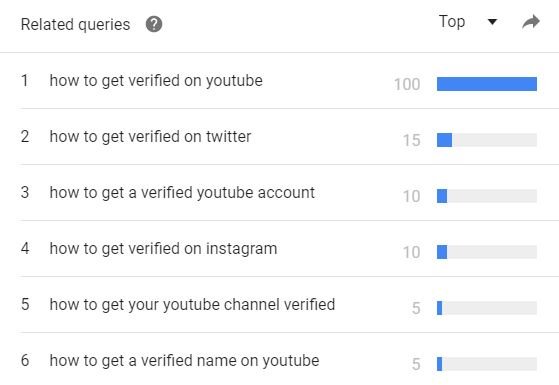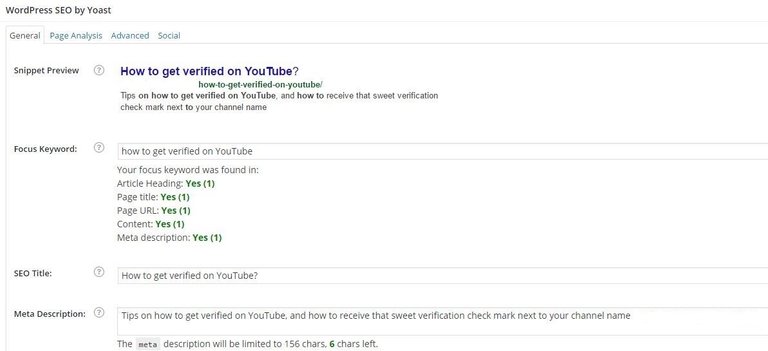Howdy, Steem!
I have been creating blogs for 6 years now, and some of them generate ~$1,000/month in affiliate marketing commission or ~$100 in AdSense revenue. A lot of the blog posts are on the first page of Google searches for certain keyphrases, which is pretty awesome, because it gets me a lot of targeted traffic, with people looking exactly for what that website offers.
Of course, there is much more to SEO that this, but here are the basic 8 points that should give you a good head-start, because most people are lazy and don't even do this.
1. Before titling the blog post, it’s best to phrase it in the way that gets searched the most often.
You can check Google Trends, AdWords Keyword Planner, or Keywordtool.io. I prefer Google Trends because it is the easiest to use, it gives you the most accurate and uncluttered data, and you don’t need to register to use it.
For example, here is Google Trends data on the phrase “How To Get YouTube Verified”. The best suggestion is “How to get verified on YouTube”
(
2. Once you know what the best phrase is, set it in the title in H1 (preferable), or if you think H1 looks too big, H2 is also an option.
H1 tells the search engines that it is the most important key phrase for the purpose of indexing, so when there is a match in the search query, the chances of the search engine pulling up your article is higher than if you didn’t use them at all. Just as a coffee shop would have a sign outside saying “coffee”, same logic applies here: it is more likely to attract more attention if everything is clearly marked.
H2 should be used for subsections, and should also contain important search phrases. It is best to use them no more than 2-3 times, depending on the article length. Try to add alternative ways of people searching for that content, like “how to get youtube verified badge”, or “how to get YouTube channel check mark”.
This is how the logic works in terms of importance:
h1 United States
h2 California
h3 Los Angeles
h4 Downtown Los Angeles
h5 Roosevelt St
h6 Your house
3. If you have an image, make sure to set the title of the blog post as an Alt Text on that image.
This should give additional weight to the key phrase from an SEO point of view.
4. If you are adding more images, it is good to set alternative search phrases, that we used in H2 and H3.
H4/H5/H6 if it is a long article) as an alt text on those images.
5. Throughout the blog post, it is also good to organically add other relevant search terms and search phrases in the article text.
For example, “In this blog post we will explain how to get verified on YouTube. [...] If you want to see how to get the check mark next to your YouTube channel name, follow these steps. [...] Getting verification mark on YouTube will make your channel look more professional” and so on.
It is best to add them organically, the same way you would use them in a conversation.
The blog reader goes first, the search engine goes second. If users leave the page shortly after clicking on it, which they will if the blog post is hard or odd to read, it increases bounce rate, which decreases the search rankings (same as on YouTube). You probably won’t like talking to the person that treats you as if you were stupid, repeating the same phrase over and over again multiple times in one sentence. From an SEO point of view, it is called ‘keyword stuffing’, and it is discouraged.
If you repeat the same phrase too many times in proportion to the article length (exact numbers are not known), the search engine will start to ignore it. It happened to me before, and it takes a lot of time and effort to fix this.
6. Try to keep the article at least 300 words or longer, preferably around 700-800 words.
Longer articles seem to be ranking higher in search engines, my guess that’s because people would likely spend more time reading the article (similar to watchtime on YouTube).
The downside of longer articles that they sometimes intimidate readers, so make sure to use proper formatting, add images between the text blocks, use headers and sub-headers (H1, H2, etc.), avoid run-on sentences, and keep the paragraphs no longer than 3 sentences - they are proven to be easier to read. We’ve had moderate success with that structure.
7. After the article is written, you need to optimize the metadata.
At this point in time, tags in Wordpress have been depreciated by most search engines, so you don’t need to worry about them. Instead, set the title and meta description.
I use the free version of Yoast SEO plugin for that. Here is how it should look:
The ‘Focus Keyword’ field is for your use only, just for the plugin to check how well the article is optimized for that phrase. The title should appear in the H1/H2, page title, in URL, and should be mentioned in meta description (will explain below) and at least once in the blog post text.
In the newer versions of Wordpress the stop words that don’t have much value in them (like ‘how’, ‘why’, ‘when’, ‘then’, etc.) can get automatically removed from the URL, so don’t worry too much if the URL has changed, as long as other important words (like “YouTube verified”) are in there you should be fine. Also, it is proven that shorter URLs get clicked on more often, so it’s best to keep them no longer than 3-4 words, if possible.
Meta description: it used to be 148, which was changed to 160 characters. If it is longer ,the search engine will snip away everything that is after. This is what will appear in the search engine when you look for something (example below).
We are starting to see meta description lose its value (you know when it is happening when you see ‘ … ’ in the meta description in Google search), as at times Google will display blog post excerpts instead of whatever is in meta description. But they still seem to have some SEO value and it’s too early to completely devalue them. So you might want to chuck the keyphrase into the meta description as well.
8. Backlinks play an important role in ranking the content.
Generally, the more backlinks lead to the article, the better it ranks. But the importance of the referral plays a big role, for example, if HuffPost, Wikipedia or Government of Canada website (e.g. a reputable site with many visitors) links to the site, it will be a big plus. If another small blog links to it, not so much, but still something.
Especially, if the website that links to us is already ranking high in search for a relevant keyphrase, it will be a big help. Which is why it is important to always post the article link on social media shortly after you post it on the blog.
Get backlinks, get clicks from the partners who already follow us on social media. Same as with YouTube, the more clicks it gets in the first 2-3 days, the better it will perform in the future.
Backlinks from your blog matter too, so whenever it makes sense, try to link other relevant articles within your new articles. The best practice is to hyperlink articles on phrases. Like this: “In the past we have talked about the most promising cryptocurrency of 2017". It is more effective to hyperlink the phrase "most promising cryptocurrency of 2017" to such article, instead of saying "we talked about the most promising cryptocurrency of 2017 here" and hyperlinking the word here.




thanks, steemit is good for SEO